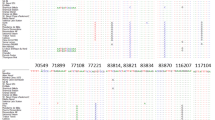Abstract.
Chloroplast DNA diversity in the olive (Olea europaea L.) complex was studied using PCR-RFLP and microsatellite markers. Fifteen chlorotypes were distinguished. We constructed a cpDNA phylogenetic tree in which five clades were recognised and located in distinct geographic areas: clade A in Central and Southern Africa, clade C in Asia, clade M in North-West Africa, clade E1 in the Mediterranean Basin and Sahara, and clade E2 in West Mediterranea. Cultivated olive clustered with Mediterranean and Saharan wild forms (clades E1 and E2). Strong genetic differentiation for cpDNA markers was observed between eastern and western Mediterranean olives, suggesting that these areas have represented different glacial refugia. Humans most likely spread one eastern chlorotype, preponderant in cultivars, across the western Mediterranean Basin. Its presence in O. e. subsp. laperrinei from the Sahara suggests a possible Mediterranean olive origin in an African population, which may have overlapped in the Southern Mediterranean during the Quaternary.
Similar content being viewed by others
Author information
Authors and Affiliations
Additional information
Electronic Publication
Rights and permissions
About this article
Cite this article
Besnard, .G., Khadari, .B., Baradat, .P. et al. Olea europaea (Oleaceae) phylogeography based on chloroplast DNA polymorphism. Theor Appl Genet 104, 1353–1361 (2002). https://doi.org/10.1007/s00122-001-0832-x
Received:
Accepted:
Issue Date:
DOI: https://doi.org/10.1007/s00122-001-0832-x




